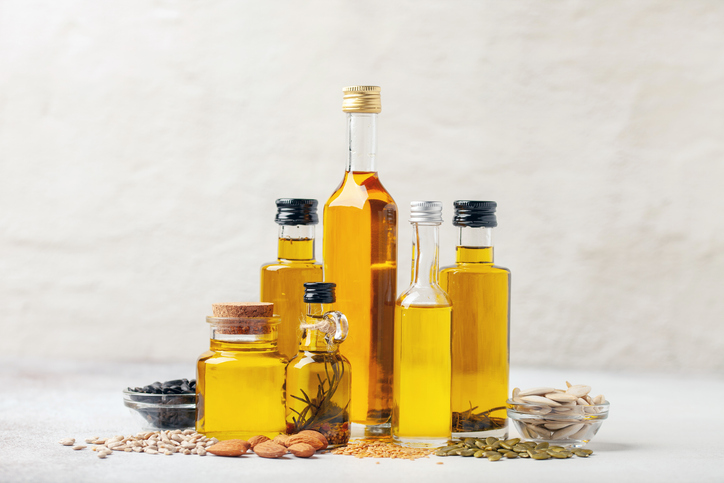Vegetable oils offer an alternative to cooking with butter or margarine, and because there are so many to choose from, you can make the most of them and their various flavours every day
By Isabelle Huot
Vegetable oils contain a mix of polyunsaturated, monounsaturated, and saturated fats, but the proportions vary depending on the type of oil. Their fatty-acid profiles determine which to choose and how to use them. Here’s a how-to guide.
9 Facts About Oils
1. For cooking. Those that contain mainly monounsaturated fats, such as olive and avocado, are recommended. Peanut and avocado oils tolerate heat best.
2. Calories. Every 15 ml (1 tbsp) of oil provides between 120 and 124 calories—peanut oil has 119 and camelina has 130—compared to 103 for butter or margarine. The latter two items contain 20 per cent water, while oil is 100 per cent fats.
3. Refrigeration. Oils that are high in polyunsaturated fats, such as flaxseed and hemp seed, must be stored in the fridge once opened; they’ll keep for one to two months.
4. Storage. When you’re shopping, check the expiry date on the bottle. A mainly monounsaturated oil (such as olive oil) will keep for more than a year.
5. Packaging. Pay attention to the colour of the bottle—darker bottles protect oil from the light.
6. Labels. Terms like “cold-pressed” or “extra virgin” indicate a product of the first pressing; these oils are higher in antioxidants. “Pure” indicates that the oil has been refined; this means it is of lower quality but would work well in cooking. Finally, “light” doesn’t mean that the oil is lower in fat but that it has a lighter taste.
7. Salad dressings. For salad dressings and vinaigrettes, choose olive, canola, or hazelnut oil, all of which are very good for heart health. Nut and sunflower-seed oils are sources of essential fats such as linoleic acid.
8. Omega-3. Flaxseed, hemp-seed, camelina, and canola oils are ideal for increasing your intake of plant-based omega-3 (alpha-linolenic acid).
9. Saturated fats. Because coconut, palm, and palm-kernel oils are high in saturated fats, you should limit your consumption.
Lots of Good Stuff in a Bottle
Vegetable oils are a source of energy for the body and promote the absorption of fat-soluble vitamins—A, D, E, and K. For example, adding a drizzle of olive oil to a kale salad helps the body better absorb the vitamin K in kale. Some vegetable oils contain fat-soluble vitamins, especially vitamins E and K. Vitamin E is an antioxidant and is involved in immune function. Vitamin K is important for blood clotting and healthy bones.
The Best for Cooking
While some vegetable oils can be used at higher cooking temperatures, others are more delicate and don’t tolerate heat. When oil smokes, that means it is breaking down. Its flavour becomes bitter, and it loses its beneficial properties.
If it’s heated for too long, an oil can produce harmful com- pounds and even ignite. The smoke point depends, among other things, on the oil’s saturated-fat content: the higher it is, the more the oil can withstand high temperatures.
The smoke point of an oil is therefore an indicator of which oils are and aren’t suitable for cooking. Oils suited for cooking include olive, canola, peanut, soybean, corn, sesame, avocado, and camelina. Flaxseed and hemp-seed oils can be used in salad dressings, smoothies, spreads, and dips, such as guacamole, hummus, and tzatziki, or to garnish dishes.
Economical Options
Olive oil is one of the heal thiest vegetable oils, and many people love the taste, so it’s great for many recipes. Unfortunately, the price of olive oil is soaring, making it less and less accessible. Canola oil, which is high in monounsaturated fat, is probably the most economical alternative. Sunflower oil, which is high in oleic acid, is also a good choice. Another option for those who like the taste of olive oil but want more for their money is to mix olive and canola oils together.
Isabelle Huot holds a Ph.D. in nutrition.






